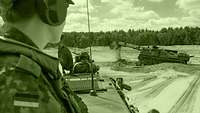Corps of engineers - The reserve never stands still
Corps of engineers - The reserve never stands still
- Date:
- Place:
- Ingolstadt
- Reading time:
- 4 MIN
“Our habitually associated active unit, 8 Mountain Engineer Battalion, provides us with plenty of opportunities for practice, and practice makes perfect.” Harald Bauer, SNCO (OR-9), is a reservist and has put his heart and soul into his profession as an engineer. 905 Engineer Battalion in Ingolstadt, an inactive unit, is his military home. To him, inactive duty means to plan and conduct training activities eye-to-eye with active units – for an attractive reserve service.
As S3 SNCO, the 55-year-old warrant officer is currently planning the training and exercise activities for the reservists of “his” battalion. In doing so, he can draw on a wealth of experience. In 1985, he took up military service with 8 Mountain Engineer Battalion, still based in Brannenburg at the time. Since then, the Bundeswehr has been on his mind in one way or another, and Bauer, who is a supervisor for building services engineering in civilian life, made an impressive career as a reservist: In his 35 years of inactive duty he has gone through the ranks from platoon commander to company headquarters section leader, up to his current assignment as S3 SNCO. Together with the commander and his deputy, he is now planning the training activities for the four companies of the inactive 905 Engineer Battalion.
Eye-to-eye interaction
“We could not do this on our own”, says Harald Bauer. The habitually associated active unit of the reserve battalion is 8 Mountain Engineer Battalion, which is based in Ingolstadt. “Without this battalion, we would be lost”, the warrant officer adds, thanking the active unit for the support. This active cooperation is the key to success. “Our 905 Engineer Battalion has somewhat more than 550 posts for reservists, and more than 400 are actually filled.” This is equivalent to more than 70 percent. As compared to other reserve battalions where only about 35 percent of all posts are filled, this number is remarkably high, Bauer explains. “This only works if active and inactive units meet on an equal footing and if they are prepared to learn from each other.” Both battalions, the active and the inactive one, equally benefit from the close cooperation. Many training activities are planned and carried out together, for example the training course for inflatable boat operators, which is currently still ongoing. “4 of the 22 students are active engineers from the habitually associated battalion; hence, there is a clear benefit for the active soldiers.”
Initiative and commitment are the driving force
Yet, the experienced S3 SNCO also knows: “The materiel and organisational support provided by the active battalion is one thing, but breathing life into the reserve is another.”
During his long time as a reservist it has become apparent time and again that the quality and quantity of training is the decisive factor for establishing an operationally ready reserve.
Here, the inactive 905 Engineer Battalion has made a tremendous development in the last few years. In 2015, there were only three training events for reservists. “Now, we have at least twelve training events per year with our reservists in the battalion. The planning effort behind all this is enormous”, the 55-year-old moves on to say. They now even have a small nucleus of what is referred to as permanent reserve duty personnel in the active battalion in order to handle these events appropriately and one after the other. “We have a huge range of training topics: In the current training, for example, we have boat operators as well as radio operators and military drivers”, he adds.
Reserve is what we make of it
Viribus unitis, with joint forces, is the motto of the inactive 905 Reserve Battalion. “That’s exactly what we are trying to put into practice. When soldiers retire from active duty, it is important to maintain momentum and retain the technical expertise to meet the challenges of national and collective defence via the reserve.” As SNCO Bauer sees it, the planned reserve assignment for retiring service personnel can be both a great chance and an exciting challenge. “There will be more reservists. It will be up to us to make training modern and attractive so that we can rely on well-trained and motivated reservists when needed.”
The experienced reservist is confident enough to go even further: “With the Battalion’s club, a supporting association, we don't forget the families, relatives or former reservists who have already passed the age limit.” To the S3 SNCO, reserve means comradeship, training, and above all: to never stand still!









